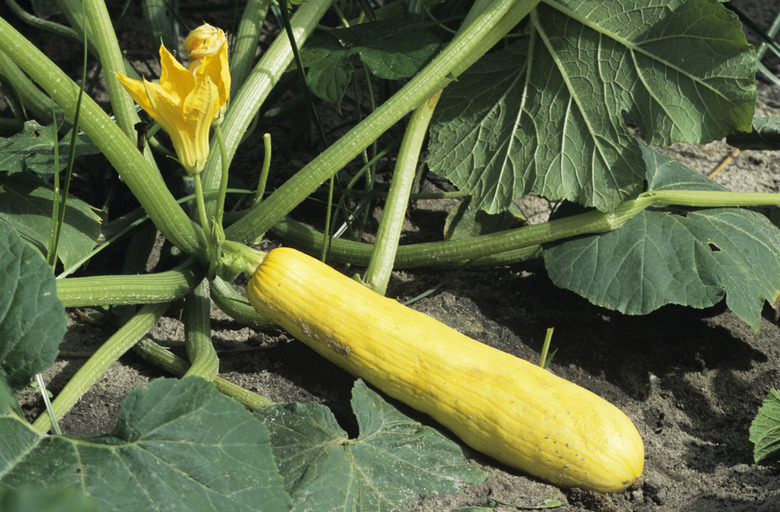How To Get Rid Of Ants & Flies On Squash Plants
Squash (Cucurbita spp.), an annual vegetable, cannot tolerate frost but can handle hot weather. Ants and vinegar flies are just two of the bugs you may find on these easy-to-grow plants. Ants don't typically damage squash, but they do protect honeydew-producing insects — such as aphids — that negatively affect vegetable plants. Vinegar flies can also damage squash; they transmit organisms to the squash that lead to spoilage. Providing good care and applying insecticides, if needed, will get rid of the ants and vinegar flies invading your squash plants.
Control Ants
Step 1
Step 1
Remove aphids and other honeydew-producing insects by spraying the plants with a garden hose every few days until the aphids are gone. Alternatively, spray the squash plants with a ready-to-use insecticidal soap to the point of runoff to kill the aphids. Insecticidal soap is safe to use around children, pregnant and nursing women, pets and beneficial insects. Repeat the insecticidal soap treatment at 10- to 14-day intervals. Continue with the remaining steps if ants are still present.
- an annual vegetable, cannot tolerate frost but can handle hot weather.
- Alternatively, spray the squash plants with a ready-to-use insecticidal soap to the point of runoff to kill the aphids.
Step 2
Step 2
Dilute 1.5 fluid ounces of a concentrated carbaryl insecticide with 1 gallon of water. Spray the squash plants with the carbaryl insecticide solution, making sure to cover the tops and undersides of the leaves to just before the point of runoff.
Step 3
Step 3
Repeat the treatment at 10- to 14-day intervals as needed. Do not apply the carbaryl insecticide three days or fewer before harvest, and never use more than six applications a year.
Control Vinegar Flies
Step 1
Step 1
Remove damaged vegetables and dispose of them immediately. Vinegar flies breed in decaying and fermenting fruits and vegetables. Harvest squash when they're ready, and do not leave the vegetables on the vine.
- Dilute 1.5 fluid ounces of a concentrated carbaryl insecticide with 1 gallon of water.
- Spray the squash plants with the carbaryl insecticide solution, making sure to cover the tops and undersides of the leaves to just before the point of runoff.
Step 2
Step 2
Remove plant matter and other debris that has fallen underneath and around the squash plants. Practicing good sanitation helps prevent future vinegar fly infestations.
Step 3
Step 3
Dilute 1/4 to 1/2 fluid ounces of a pyrethrum insecticide concentrate in 1 gallon of water. Pyrethrum insecticides are a botanical pesticide derived from chrysanthemums.
Step 4
Step 4
Pour the mixture into a pump sprayer. Cover the entire squash plant — including the undersides of the leaves — with the solution. Pesticides should only be used as a last resort when other control measures have been exhausted.
- Remove plant matter and other debris that has fallen underneath and around the squash plants.
- Pyrethrum insecticides are a botanical pesticide derived from chrysanthemums.
Tip
Wear protective clothing when using pyrethrum insecticide.
Tip
Follow the instructions and warnings printed on the pyrethrum insecticide label. This will prevent unintended damage to the squash plants and increase the effectiveness of the pesticide.
Warning
Avoid using pyrethrum insecticides when bees are active.
Warning
Keep children and pets away from the area until the insecticide is dry.
Warning
Even though there is no data about the risks of pyrethrin insecticides to pregnant or nursing women, it's best to err on the side of caution; pregnant and nursing women should stay out of the area until the insecticide has dried.
Warning
Contact poison control if the insecticide is ingested.
Things Needed
- Hose
- Ready-to-use insecticidal soap
- Concentrate carbaryl insecticide
- Pyrethrum insecticide concentrate
- Pump sprayer
